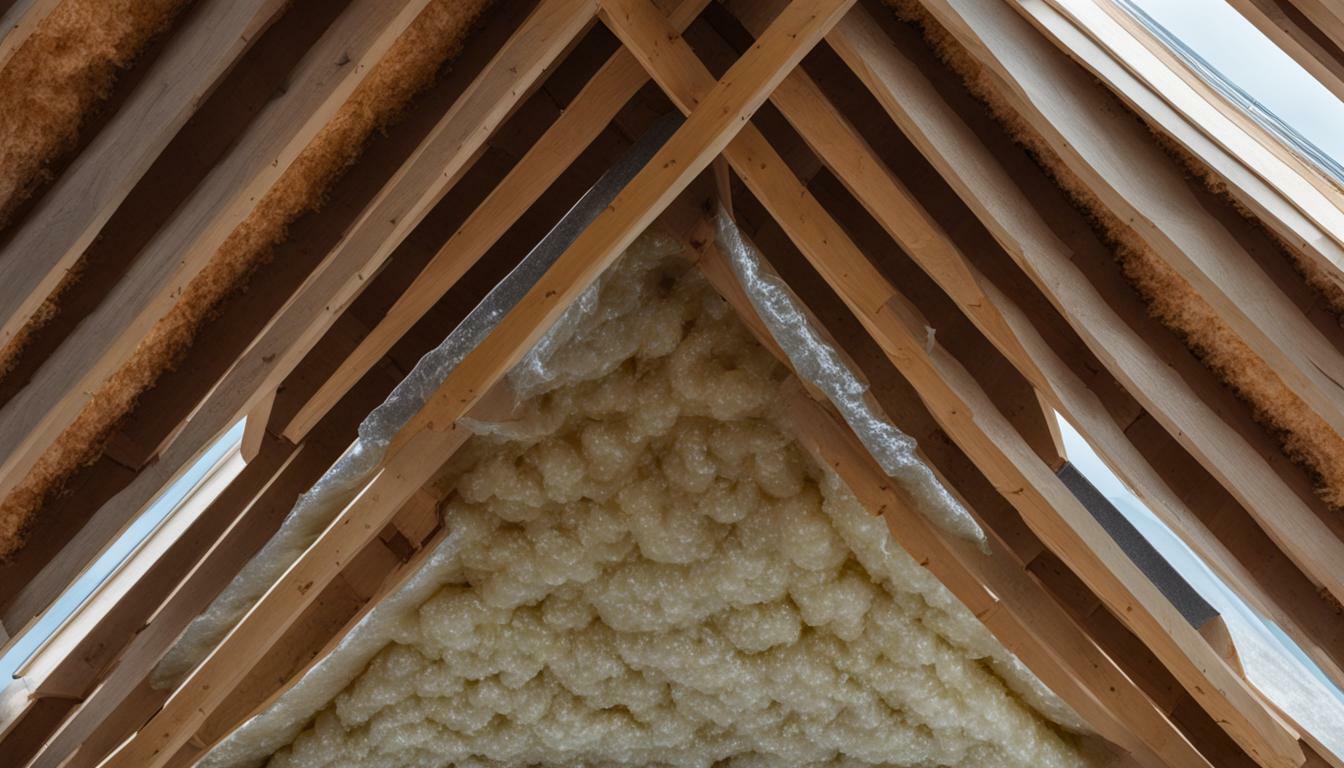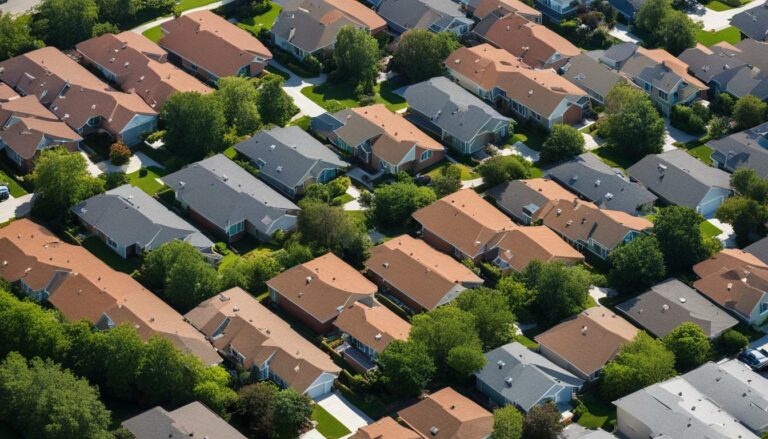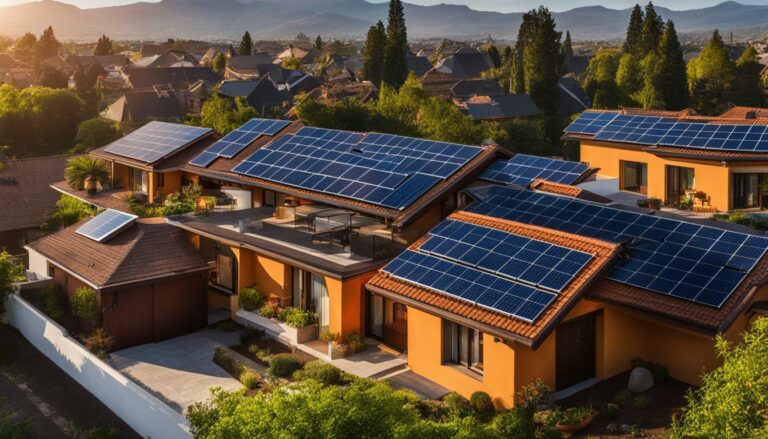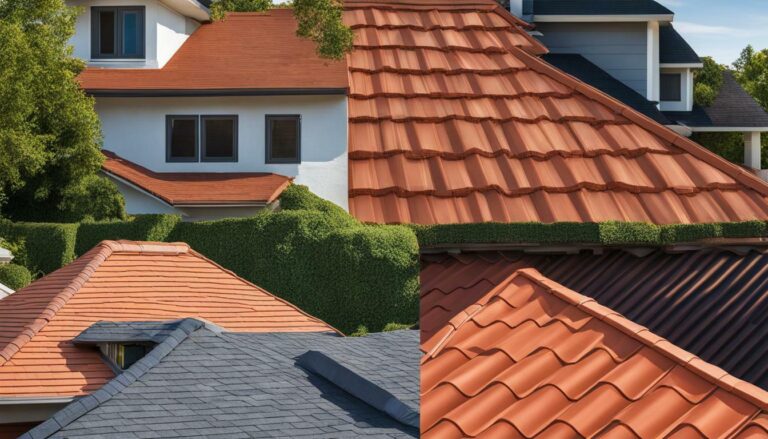Maximize Comfort with Attic Insulation and Roofing Solutions
When it comes to creating a comfortable and energy-efficient home, attic insulation and roofing play a crucial role. Proper attic insulation and ventilation not only regulate temperature and moisture levels but also contribute to the longevity of your roof, savings on heating and cooling costs, and a reduction in greenhouse gas emissions.
- Attic insulation and ventilation work together to regulate temperature and moisture levels.
- Proper attic ventilation requires a balanced ratio of intake and exhaust vents.
- Attic insulation helps control air flow and prevent heat transfer.
- Sealing air leaks in the attic maximizes insulation effectiveness.
- Maximizing attic insulation and roofing solutions creates a more comfortable and energy-efficient home environment.
The Benefits of Proper Attic Insulation and Ventilation
Proper attic insulation and ventilation offer a multitude of benefits, ranging from enhanced energy efficiency to a longer lifespan for your roof. When your attic is well-insulated, it helps to regulate temperature and moisture levels, preventing heat loss in the winter and heat gain in the summer. This not only keeps your home more comfortable year-round but also reduces the load on your heating and cooling systems, resulting in lower energy costs.
Additionally, proper attic ventilation plays a crucial role in maintaining the health of your roof. By allowing air to circulate, it helps prevent the buildup of moisture, which can lead to mold and rot. A well-ventilated attic also helps to extend the life of your roof by reducing the risk of shingle damage caused by excessive heat and moisture.
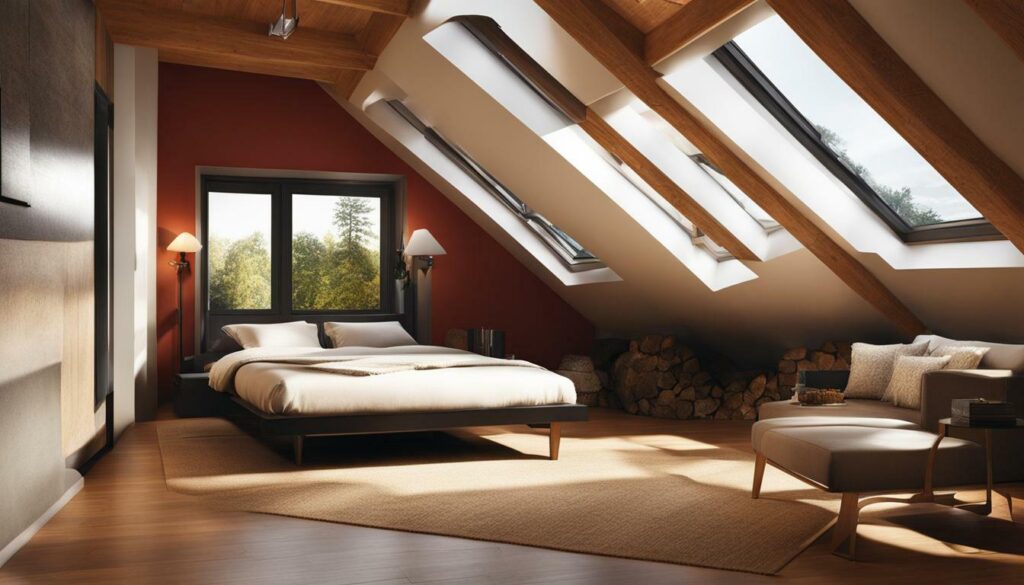
To ensure optimum results, it is important to have a balanced attic ventilation system. The International Building Code and International Residential Code set forth the minimum requirements for attic ventilation, typically specifying a ventilation ratio of 1:150. However, industry leader Owens Corning recommends combining this ratio with balanced intake and exhaust ventilation for optimal performance.
When it comes to insulation materials, fiberglass batts and blankets are commonly used in attics due to their excellent thermal performance and ease of installation. These materials provide a high R-value, which measures the insulation’s resistance to heat flow. By increasing the R-value of your attic insulation, you can further enhance energy efficiency and reduce heating and cooling costs.
Understanding Attic Ventilation Requirements
To ensure proper attic ventilation, it is essential to understand the ventilation requirements set by building codes and industry recommendations. Attic ventilation plays a crucial role in maintaining the health and longevity of your roofing system. It helps regulate temperature and moisture levels in the attic and on the roof deck, preventing the buildup of heat, condensation, and potential damage.
The International Building Code and International Residential Code specify minimum ventilation requirements for attics. The typical guideline is a ventilation ratio of 1:150, meaning that one square foot of net free ventilating area should be provided for every 150 square feet of attic floor area. However, to achieve optimal results, it is recommended to balance the intake and exhaust ventilation for a well-functioning attic system.
Industry recommendations for balanced ventilation
| Ventilation Type | Minimum Requirement |
|---|---|
| Intake Ventilation | 50% of total net free ventilating area |
| Exhaust Ventilation | 50% of total net free ventilating area |
By providing a balanced combination of intake and exhaust vents, you can ensure proper air circulation throughout the attic. Intake vents, such as soffit vents or eave vents, allow fresh air to enter the attic, while exhaust vents, such as ridge vents or roof vents, allow hot air to escape. This balanced airflow helps prevent moisture buildup, reduce the risk of mold and mildew growth, and prolong the lifespan of your roofing materials.
Consulting with professional roofing contractors who specialize in attic insulation services and roofing services is highly recommended to determine the specific ventilation requirements for your home. They can assess your attic and recommend the best ventilation system tailored to your needs, ensuring compliance with building codes and industry standards.
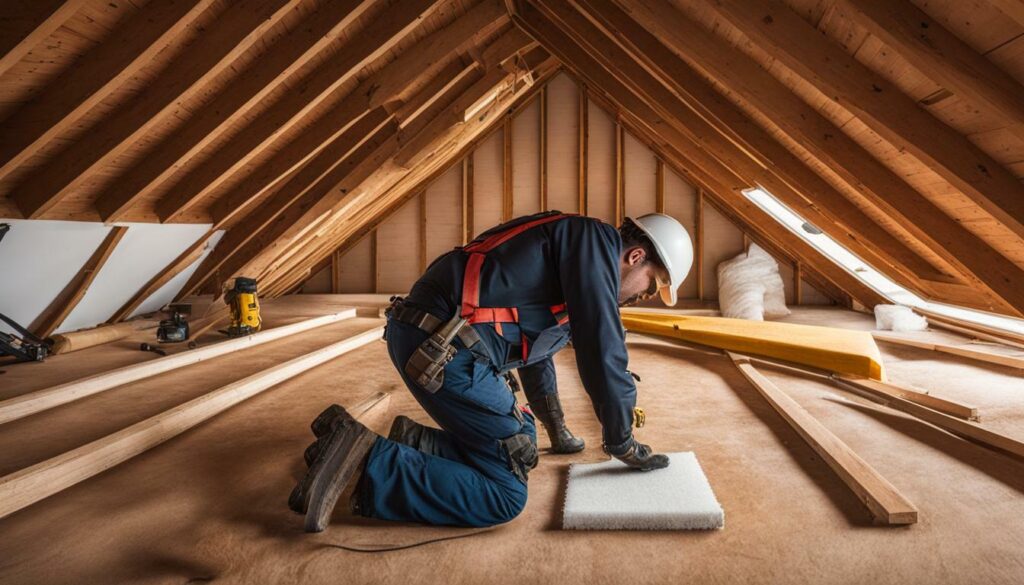
Attic insulation acts as a crucial barrier, controlling air flow and preventing heat transfer to maintain a comfortable temperature in your home. It plays a fundamental role in regulating the temperature throughout the year, reducing the need for excessive heating and cooling. Proper insulation ensures that your home remains cool in hot summer months and warm during the cold winter season.
The insulation’s ability to resist conductive heat flow is measured by its R-value. Higher R-values indicate greater resistance to heat flow, providing better insulation performance. Commonly used insulation materials, such as fiberglass batts and blankets, effectively trap air pockets, minimizing heat transfer and maximizing energy efficiency in your home.
When considering attic insulation options, it is important to choose materials with an appropriate R-value for your region’s climate. Consult with insulation contractors or professionals to determine the most suitable insulation type and thickness based on your specific needs. It is also crucial to ensure proper installation, which includes sealing any air leaks in the attic, to optimize insulation effectiveness.
| Insulation Material | R-Value per Inch |
|---|---|
| Fiberglass Batt | 3.1-4.3 |
| Cellulose | 3.1-3.8 |
| Spray Foam | 6.0-7.0 |
| Mineral Wool | 3.0-4.2 |
By ensuring your attic is properly insulated, you can significantly reduce heat loss or gain, resulting in improved comfort and energy efficiency. This not only enhances the overall quality of your living environment but also helps lower your heating and cooling costs. A well-insulated attic contributes to a more sustainable home, reducing greenhouse gas emissions and promoting a greener future.

DIY Attic Insulation Installation and Air Sealing
If you’re a handy homeowner, you may consider installing attic insulation yourself while paying attention to proper air sealing techniques. This can be a cost-effective option, but it’s important to do it right to ensure maximum energy efficiency and comfort in your home.
Before you begin the insulation installation, it’s crucial to assess your attic for any existing air leaks. These leaks can significantly reduce the effectiveness of the insulation, allowing hot or cold air to escape and increasing your energy costs. Use a smoke pen or incense stick to detect any drafts around doors, windows, electrical outlets, and other potential sources of air leakage.
Once you have identified and sealed any air leaks, you can proceed with the insulation installation. Fiberglass batts and blankets are commonly used insulation materials and can easily be installed in your attic. Remember to wear protective clothing, gloves, and a mask to prevent any skin irritation or respiratory issues while handling insulation.
As you install the insulation, be careful not to compress it, as this can reduce its effectiveness. Make sure to cover all exposed areas, including the attic floor, walls, and any knee walls or sloped ceilings. Take into account any obstructions such as pipes or ductwork and cut the insulation to fit around them.
When the insulation installation is complete, take a step back and admire your handiwork. You have taken an important step towards a more energy-efficient home. Remember, if you’re unsure about any aspect of the installation process, it’s always a good idea to consult with a professional insulation contractor who can ensure that the job is done correctly and according to local building codes.
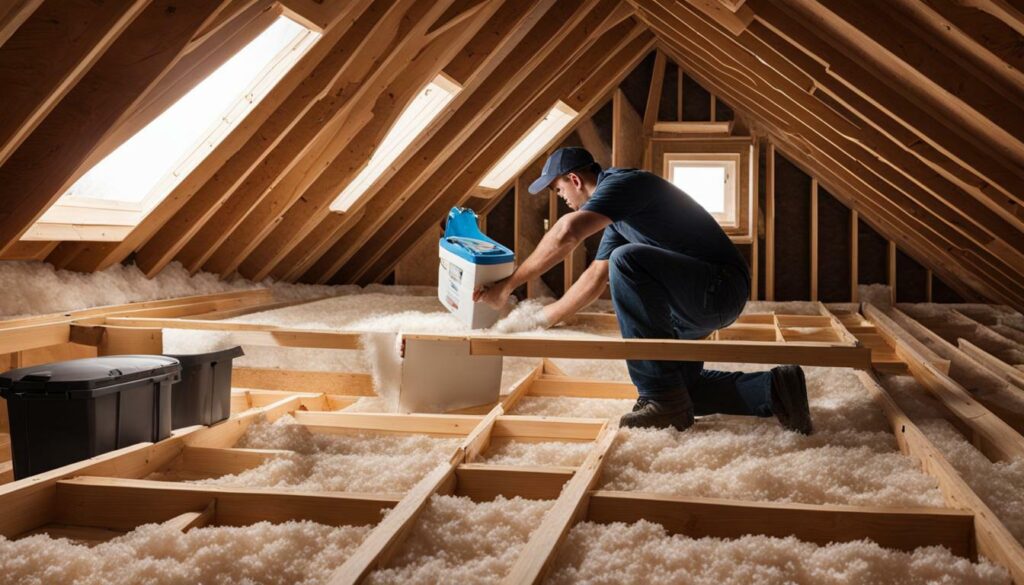
By investing in proper attic insulation and air sealing, you can enjoy substantial energy savings and lower your heating and cooling costs. Attic insulation works by preventing heat transfer, keeping your home warm in the winter and cool in the summer. The insulation’s resistance to heat flow, known as the R-value, is an essential factor in determining its effectiveness. Higher R-values provide greater resistance to heat flow, resulting in improved energy efficiency.
Insulation materials such as fiberglass batts and blankets are commonly used in attics. They can be installed yourself, making it a cost-effective solution. However, it is crucial to seal any air leaks in the attic before adding insulation. Air leaks can significantly reduce the effectiveness of insulation and lead to energy loss. Sealing air leaks helps to create an airtight barrier and enhance the insulation’s performance.
According to studies, up to 40% of air leakage in a home can occur through the attic floor. This means that without proper insulation and air sealing, a considerable amount of conditioned air, and your hard-earned money, can be escaping through your attic. By sealing air leaks and adding insulation, you can create a more energy-efficient home and reduce your carbon footprint.
To illustrate the potential energy and cost savings, consider this example: a typical homeowner can save up to 20% on heating and cooling costs by properly insulating and sealing their attic. For a household spending $2,000 per year on energy bills, that’s a savings of $400 annually. Over time, these savings can add up significantly, making your investment in attic insulation and air sealing well worth it.
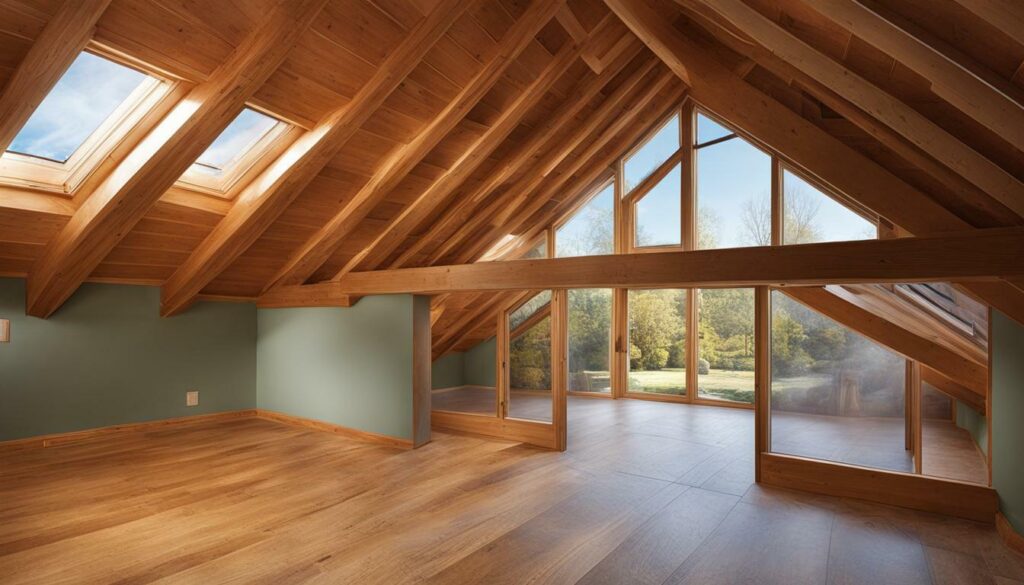
In summary, improving attic insulation and air sealing can lead to substantial energy savings and lower heating and cooling costs. By creating a thermal barrier and preventing air leakage, you can improve the overall energy efficiency of your home. Consider consulting with a professional insulation contractor to ensure proper installation and maximize the effectiveness of your attic insulation and air sealing efforts.
Enhancing Comfort and Energy Efficiency Through Roofing Solutions
Achieving optimal comfort and energy efficiency is a collaborative effort between attic insulation and high-quality roofing solutions. When it comes to creating a more comfortable and energy-efficient home environment, a well-functioning roofing system plays a crucial role. Not only does it protect your home from the elements, but it also works in tandem with attic insulation to regulate temperature and moisture levels.
Proper attic ventilation is essential for maintaining a healthy roof and maximizing energy efficiency. It involves a balanced combination of intake and exhaust vents to ensure proper airflow throughout the attic and on the roof deck. By adhering to the ventilation requirements set forth by the International Building Code and International Residential Code, as well as following the recommendations of industry leaders like Owens Corning, you can achieve the best results.
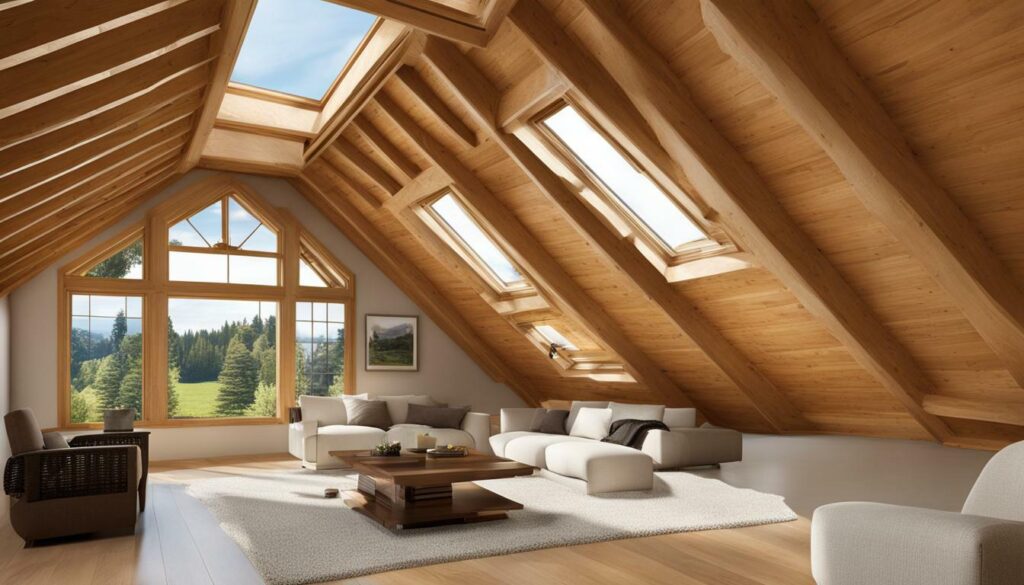
Attic insulation plays a vital role in temperature control and energy conservation. By preventing heat transfer and air leakage, insulation helps maintain a consistent and comfortable indoor environment throughout the year. Insulation materials such as fiberglass batts and blankets are commonly used and can be installed with relative ease. Additionally, sealing any air leaks in the attic is crucial to maximize the effectiveness of the insulation.
By combining proper attic insulation with high-quality roofing solutions, homeowners can experience significant energy and cost savings. Up to 40% of air leakage in a home can occur through the attic floor, making it essential to address air leaks before adding insulation. Consulting with professional roofing contractors ensures the insulation and ventilation systems are installed correctly and comply with local building codes and standards.
| Benefits of Roofing Solutions |
|---|
| Extended roof lifespan |
| Improved energy efficiency |
| Reduced heating and cooling costs |
| Enhanced indoor comfort |
Conclusion
In conclusion, proper attic insulation and high-quality roofing solutions are integral to maximizing comfort and energy efficiency in your home. By taking the necessary steps to ensure a well-functioning attic system and a properly ventilated roof, you can enjoy a more comfortable living environment, save money on energy costs, and reduce your overall carbon footprint. Remember to consult with professionals to ensure the proper installation of these systems and adhere to local building codes.
Creating a More Comfortable and Energy-Efficient Home Environment
By maximizing attic insulation and implementing proper roofing ventilation, you can transform your home into a more comfortable and energy-efficient living space. Attic insulation and roofing solutions go hand in hand to create a well-insulated and well-ventilated environment that optimizes temperature control and reduces energy consumption.
Proper attic insulation plays a crucial role in regulating air flow and heat transfer between your living spaces and the attic. This helps maintain a consistent temperature throughout the year and prevents energy loss. Insulation materials such as fiberglass batts and blankets are commonly used and can be easily installed in the attic to enhance thermal resistance and energy efficiency.
At the same time, proper roofing ventilation ensures adequate air circulation in the attic and on the roof deck. This helps prevent moisture buildup and the formation of ice dams, which can lead to roof damage. An ample amount of balanced intake and exhaust vents allows for the removal of excess heat and moisture, reducing the strain on your HVAC system and enhancing energy efficiency.
To better understand the benefits of proper attic insulation and roofing ventilation, consider the following summarized points:
- Improved temperature control and comfort in your home.
- Reduced heating and cooling costs, leading to long-term savings.
- Extended lifespan of your roof by preventing moisture-related damage.
- Reduced greenhouse gas emissions and environmental impact.

By prioritizing attic insulation and roofing solutions, you are not only investing in immediate comfort and energy savings but also contributing to a sustainable future. If you’re unsure about the best approach for your home, it’s always wise to consult with professional roofing contractors who can assess your attic’s insulation needs and provide expert guidance on proper ventilation installation.
| Key Considerations | Benefits |
|---|---|
| Proper attic insulation |
|
| Roofing ventilation |
|
Remember, a well-insulated and well-ventilated attic is a key component in creating a comfortable and energy-efficient home environment. Don’t overlook the importance of proper attic insulation and roofing solutions, and take advantage of the potential energy and cost savings they offer.
Conclusion
Attic insulation and roofing solutions are essential components in achieving a comfortable, energy-efficient home. By properly insulating your attic and ensuring adequate roofing ventilation, you can maximize comfort, extend the lifespan of your roof, and reduce heating and cooling costs.
Proper attic ventilation is crucial in regulating temperature and moisture levels in your attic and on the roof deck. The International Building Code and International Residential Code establish minimum ventilation requirements, but for optimal results, Owens Corning recommends a balanced ventilation system with a ratio of 1:150 between intake and exhaust vents.
Attic insulation plays a vital role in controlling air flow and preventing heat transfer. Different insulation materials, such as fiberglass batts and blankets, can be easily installed in the attic to enhance energy efficiency. It is important to seal any air leaks in the attic to maximize the insulation’s effectiveness.
By investing in proper attic insulation and air sealing, you can save energy and reduce your heating and cooling costs. Up to 40% of air leakage in a home can occur through the attic floor, making it essential to seal air leaks before adding insulation. This will create a more comfortable and energy-efficient home environment for you and your family.
For the best results, consider consulting with a professional roofing contractor who can ensure that your insulation and ventilation systems are installed correctly and comply with local building codes and standards. Their expertise will help you achieve the maximum benefits of attic insulation and roofing solutions, creating a space that is both comfortable and energy-efficient.
FAQ
Q: What are the benefits of proper attic insulation and ventilation?
A: Proper attic insulation and ventilation help improve energy efficiency, extend the life of your roof, save money on heating and cooling costs, and reduce greenhouse gas emissions.
Q: What are the attic ventilation requirements?
A: The International Building Code and International Residential Code require a minimum ventilation ratio of 1:150. Owens Corning recommends a 1:150 ratio combined with balanced intake and exhaust ventilation for optimum results.
Q: How does attic insulation control temperature?
A: Attic insulation prevents heat transfer to cooler, unheated spaces in both winter and summer. The insulation’s resistance to heat flow, expressed as an R-value, helps regulate temperature and keep your home comfortable.
Q: Can I install attic insulation myself?
A: Yes, insulation materials such as fiberglass batts and blankets can be installed in the attic yourself. However, it is important to consult with professionals to ensure proper installation and maximize effectiveness.
Q: Why is air sealing important in the attic?
A: Air sealing in the attic helps prevent air leakage and maximize the effectiveness of insulation. Up to 40% of air leakage in a home can occur through the attic floor, so sealing air leaks is essential to save energy and reduce heating and cooling costs.
Q: How can proper attic insulation and air sealing save energy and money?
A: By preventing air leakage and reducing heating and cooling costs, proper attic insulation and air sealing can help save energy and money in your home.
Q: How do roofing solutions enhance comfort and energy efficiency?
A: Combining proper attic insulation with quality roofing solutions creates a more comfortable and energy-efficient home environment. Professional roofing contractors can ensure proper installation and compliance with building codes.
Q: How can I create a more comfortable and energy-efficient home environment?
A: By prioritizing attic insulation and roofing solutions, you can create a more comfortable and energy-efficient home. Consult with professionals to ensure proper installation and maximize the benefits of these upgrades.
